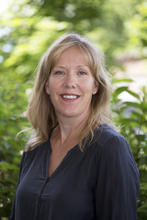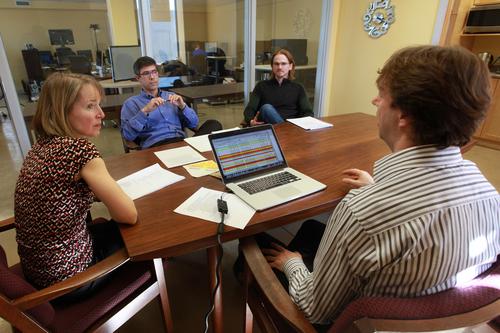When you’re in a highly demanding program like Engineering at UWaterloo, your support systems can determine whether you succeed or not. Throw in minority status – like making up 30 percent in first-year Engineering students, as women did last year – and you might face a challenge.
A small community can provide support and help mitigate that challenge, so in that respect, St. Paul’s has always been helpful to women in Engineering. As of this fall, though, the support will be more overt, with the opening of a new Living-Learning Community specifically for women in Engineering. The Community will allow for 35-40 female Engineering students to live together in residence and get support from upper-year Engineering peers to ensure that they make solid connections and networks.
According to Lyndia Stacey, Outreach Coordinator for Women in Engineering at UWaterloo and herself an engineer, the percentage of women in Engineering tends to drop by graduation. She says, “While there are many male allies in engineering and we are moving forward, it is a long-term challenge that women are treated differently. This can include unconscious biases and micro-aggressions, as well as more overt discrimination.”
 Historically, one in five engineers at St. Paul’s have been female. One of these is Winnie Lam, who graduated with a degree in Systems Design Engineering in 2000 and lived at St. Paul’s in 1995-96. Today, she works for Google where she leads the team responsible for environmental sustainability of Google's data centres. She says, “Being an under-represented group, women can experience challenges that men don't, at school and at work. Women engineers sometimes need to prove themselves more so than men with similar skills before earning the credibility that they deserve. Some women also need to work extra hard at being assertive, yet still be likeable, in order for their voices to be heard.”
Historically, one in five engineers at St. Paul’s have been female. One of these is Winnie Lam, who graduated with a degree in Systems Design Engineering in 2000 and lived at St. Paul’s in 1995-96. Today, she works for Google where she leads the team responsible for environmental sustainability of Google's data centres. She says, “Being an under-represented group, women can experience challenges that men don't, at school and at work. Women engineers sometimes need to prove themselves more so than men with similar skills before earning the credibility that they deserve. Some women also need to work extra hard at being assertive, yet still be likeable, in order for their voices to be heard.”
Julia Salvini, who runs her own engineering consulting firm specializing in transportation and planning, graduated in 1998 from Civil Engineering and lived at St. Paul’s between 1993 and 1995. She says,
As a woman engineer, I’m very conscious that a lot of women who have come before us have tried to be sure women are treated equally. We always need to be careful about not segregating ourselves. But I think women can support one another and do things in a way that doesn’t make us simply form a club.
Salvini has worked hard to make sure that people feel welcomed in engineering no matter what their background, gender, culture, or age. She sees tremendous value in the Living-Learning Community. “I love the idea that women Engineering students can live together a nd support one another. That good support network was a big part of my time at St. Paul’s. And women in any profession need to support each other.”
nd support one another. That good support network was a big part of my time at St. Paul’s. And women in any profession need to support each other.”
That support network is what excites Lyndia Stacey. “The transition to first-year university is tough for anyone, but it’s particularly hard in engineering. Engineering is filled with high achievers who are often shocked when their grades drop in university. Having those peer leaders will be good for the mental health of these engineering students.”
The mental health of engineering students is important to Anne Vivian-Scott, who obtained her Chemical Engineering degree in 1989, and lived at St. Paul’s in 1984-85. Today, Vivian-Scott is president and CEO of BKIN Technologies Inc., a robotic technology company based in Kingston, as well as the mother of a UWaterloo Engineering student. She says, “My engineering experience at university was intense, but today the pressure is ridiculously overwhelming and scary for students.” She believes that a Living-Learning Community can help bring balance to such students.

“Students need to be part of a community for balance and for maintaining centred-ness and engagement in things beyond their classes, grades, and co-op jobs.” In her own life, Vivian-Scott recalls she stopped running and swimming because of school pressures, not realizing the benefit of such activities for stress reduction and balance. She sees value in peer leaders and alumnae who serve as mentors who understand intense Engineering students. She also believes that curated activities within a Living-Learning Community offer a good way of helping students engage meaningfully with a wider community.
And despite their real cautions about the stresses of engineering, the St. Paul’s Engineering alumnae were universally positive about the opportunities in their field.
Salvini says, “I have had great experiences as a woman in engineering. I want young women to know that there are lots of great employers, clients, and companies that are inclusive of women and value what different people bring to the table. My first job experience where I was treated very well helped me to expect not to be treated differently, and that expectation helped build my confidence.”
Building that confidence is exactly what this Living-Learning community is designed for. Lam says, “Having a community where female engineering students can discuss these topics comfortably can go a long way towards propelling their careers.”
In offering this new program, St. Paul's is drawing on its expertise with the long-standing Faculty of Environment LLC (started in 2009), and the newer Social Impact LLC (2016).








